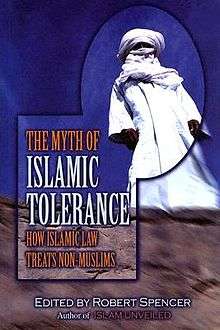The Myth of Islamic Tolerance
 Book cover | |
| Author | Robert Spencer (editor) |
|---|---|
| Language | English |
| Subject | Islamic Studies |
| Publisher | Prometheus Books |
Publication date | January 31, 2005 |
| Media type | Hardcover |
| Pages | 594 |
| ISBN | 978-1-59102-249-7 |
| OCLC | 55982393 |
| 297.2/8 22 | |
| LC Class | KBP2449 .M98 2005 |
The Myth of Islamic Tolerance: How Islamic Law Treats Non-Muslims is a collection of 63 essays edited by Robert Spencer. It deals with the history of non-Muslim populations during and after the conquest of their lands by Muslims.[1][2]
Overview
The book contains 17 chapters by Bat Ye'or, as well as essays by Ibn Warraq, Walid Phares, David Littman, Patrick Sookhdeo, and Mark Durie.[3] The writers opine that attitudes of Muslims today are informed by the tenets of Islam.[2] It covers topics including sharia law and antisemitism.[4]
Reviews and reception
A November 2004 review of the book in Publishers Weekly said the book's theme "merits exploration", but that the book does not explain why Islam is "inherently intolerant".[5] An August 2005 review of the book in Asia Times opined that:
... The Myth of Islamic Tolerance warrants our attention. Any study of contemporary Islam would be incomplete without it. Collectively, the essays expose an unsettling fact: that Islam's famed tolerance of non-Muslims has over the centuries fallen well short of an embrace.... However, the book is full of flagrant distortions and glaring omissions.[2]
In September 2005 book review in The Middle East Journal reviewed the book,[6] and a June 2006 book review in First Things said that the book "might be described as an extended bill of indictment against Islam and a debunking of the still commonly heard claim that Islam has been and is tolerant of minorities."[7]
Writing in National Review in March 2007, Dinesh D'Souza described The Myth of Islamic Tolerance as being attractive to those who would like to criticize Muslims at large for 9/11.[8] He suggested that the book uses a strategy of selective quotations from the Koran, which he calls "history for dummies".[8]
Dr. Akbar Ahmed, professor of Islamic studies at American University, described the book as an example of one of the most humane religions in the world being misrepresented as a violent one.[9] In his book Beyond the Veneer, Ioannis Gatsiounis says that the book "struggles to find an enlightened balance", as it sometimes overlooks complexities while at the same time avoiding a trend in many circles of viewing the issue it addresses solely as a non-religious one.[10]
See also
References
- ↑ Andrew C. McCarthy (March 27, 2006). "Cold Comfort on Islam and Apostasy". National Review. Retrieved 7 May 2015.
- 1 2 3 Ioannis Gatsiounis (August 27, 2005). "Book Review: Addressing Muslim rage; Myth of Islamic Tolerance". Asia Times. Retrieved January 17, 2012.
- ↑ (subscription required) "The Myth of Islamic Tolerance: How Islamic Law Treats Non-Muslims, by Robert Spencer, Prometheus Books (2005)
- ↑ Bawer, Bruce (2006). "Crisis in Europe". Hudson Review. 58 (4): 577. JSTOR 20464487.
- ↑ "The Myth of Islamic Tolerance: How Islamic Law Treats Non-Muslims". http://www.publishersweekly.com. PWxyz LLC. Retrieved 7 May 2015. External link in
|website=(help) - ↑ (subscription required) Yildiz, Murat (October 1, 2005). "Myth of Islamic Tolerance: How Islamic Law Treats Non-Muslims". The Middle East Journal. Retrieved January 19, 2012.
- ↑ "The Myth or Islamic Tolerance: How Islamic Law Treats Non-Muslims". First Things. June 1, 2006. Retrieved January 19, 2012.
- 1 2 Dinesh D'Souza (March 14, 2007). "The Closing of the Conservative Mind, Part III". National Review. Retrieved 7 May 2015.
- ↑ Khalid Hasan (November 29, 2006). "British channel to screen documentary on Islamic art". Daily Times. Retrieved 7 May 2015.
- ↑ Ioannis Gatsiounis (2008). Beyond the Veneer: Malaysia's struggle for diginity and direction. Monsoon Books. ISBN 981-08-0657-4. Retrieved January 17, 2012.
External links
- (subscription required) Book review by Midwest Book Review, April 1, 2005
- Book review by Bruce Thornton, August 6, 2005
- Book review on Asia Times, August 27, 2005